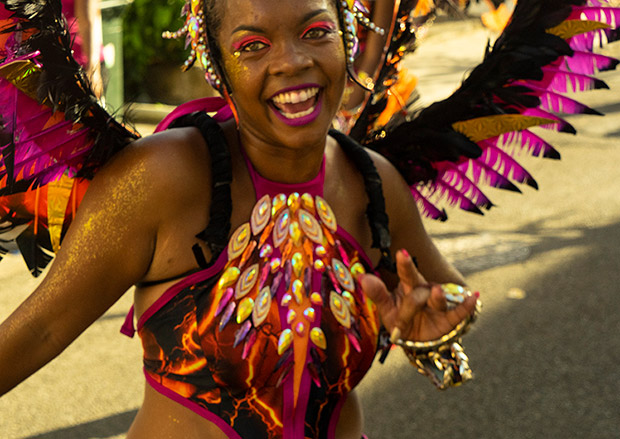
© Don Burmeister. (Click image for larger version)
To say Carnival can be an all-consuming celebration of life seems something of an understatement for some communities and nations. That’s certainly what Susanna Sloat found during her recent Eastern Caribbean jaunt to Guadeloupe, and it’s spawned a lively and detailed account of the richness and diversity of it all. And the spelling? Well, it’s always Carnaval in Guadeloupe…
www.carnavaldeguadeloupe.com
Susanna visited 12-25 February 2020
For us, Carnaval began, inadvertently, soon after arriving in Guadeloupe on February 12. Carnaval in Guadeloupe begins at the start of January and Carnaval events happen all over the islands. It took a while to get our rental car at the airport and when we entered the center of our first destination, Le Gosier, we found ourselves diverted by a children’s Carnaval parade.
After checking in at our b&b, Les Bananiers, and setting out again, we fell into an impenetrable traffic jam – the main street was the paraders’ street. Led to a bypass route by the gestures of a helpful local man, we managed to park and arrive at the children’s parade in time to see the last Carnaval band in full. Girls in madras plaid dresses and headwraps, typical of 19th century Guadeloupean women’s wear, assembled in the street, along with a few boys, and other girls, also in long dresses, but in solid colors like violet, with hanging face coverings as if in an imagined harem.
A band with steelpan oil drum tops, snare drum tops, and huge blue plastic barrel drums played an insistent rhythm that would become very familiar. Girls bounced to the music, hips smoothing out, and some bystanders did too. On a red carpet girls and boys did their dance routine with bouncing bodies and hips and crossings with suggestions of old set dances.
Afterwards, in a nearby park that went down to the sea, a Carnaval band with the same instruments plus more commercially produced big bass drums, and a couple of young men playing conch shells, led a drum circle with the same catchy rhythm. A few local women, impelled by the drums, bent forward, and thrust and circled hips.
Over the next few days we caught other instances of children celebrating Carnaval. In the town of Le Moule, on the east coast of Grande-Terre, just south of the excellent Musée Archéologique Edgar Clerc, a must if you are interested in the history of the pre-Columbian inhabitants of Guadeloupe, we found a children’s Carnaval at a school. The courtyard was full of kids in homemade costumes, and girls using their hips and upper bodies expressively to the rhythms of the drums.
On Saturday in Pointe-à-Pitre, the commercial and population center of Guadeloupe, in the big square with the tourist-oriented spice market pavilion, a small young Carnaval band began to play. Three boys or men danced, the best being a man in a gorilla suit and mask, skittering and jumping, adding isolations to his vigorous moves as he stutter-stepped forward. The band moved across the square, disappeared, and returned, to move across and down another street.
This was our first glimpse of a Guadeloupean gorilla, a figure that kept reappearing in Carnaval parades. Another first was a boy snapping a large whip – while whip- snapping was only occasionally seen among men’s groups (and they were likely to be gorillas) at Carnaval, lots and lots of boys were practicing their snaps. Having seen a man’s eye badly injured by a whip at a pre-Easter carnival in Cabral in the Dominican Republic in 2007, I was upset to see how popular whips are among boys in Guadeloupe.
That very day, on our way to Memorial ACTe, the architecturally spectacular, state of the art museum about the history of the slave trade in general and its impact on Guadeloupe in particular, we saw more small boys practicing their whip throws. At Memorial ACTe everyone gets headphones, which tell stories about slavery and Guadeloupean culture and provide soundtracks to videos of dancing and Carnaval. Most unusual is the hallway between the two sides of the museum, where the headphones deliver two major and irresistible African music hits of decades ago. Part of the way you hear Miriam Makeba singing “Pata, Pata;” the rest of the way you hear Nigeria’s Prince Nico Mbarga’s Rocofil Jazz doing their mega-hit, “Sweet Mother.”

© Don Burmeister. (Click image for larger version)
Back downtown, a substantial children’s Carnaval group filed across the Place de la Victoire. But the reason to go to Pointe-à-Pitre on a Saturday – and not just at Carnaval time, is to hear Gwoka (or Gwo ka). At the fruit and vegetable market by the harbor for small boats we heard Gwoka from across the water. We were lured there by the music and found a few stands by the water selling fresh fish, with people quickly scaling them, some big octopi, and a bin of large langoustines.
Across the way, under a covered structure, two men astride barrel drums (one large, one medium) and a lead drummer with a djembe played alluring Gwoka rhythms. It was tempting to stay, but we had seen little of the city and knew the main site for Gwoka was near the statue of a Gwoka drummer on Rue St. John Perse. This is a pedestrian street (near the handsome house where the poet lived as a child) that leads to the spice market square and is full of tourist-oriented stands.
When it rained we took shelter under the eaves of a café. It rains a lot in Guadeloupe, often for short periods, but sometimes voluminously – those lush rainforests need to be fed. Hearing the sound of drums on Rue St. John Perse we made our way in light rain to the Gwoka drummers seated under an awning and spent a couple of hours there. I was mesmerized.
The lead singer (and euro collector), a large man with a big white beard and dreadlocks piled on his head, began each song with a chant in Creole, with call and response singing from the drummers and others at the back of them playing ti-bwa sticks and chacha (shekere). Then the drummers, two seated on barrel drums, and the djembe lead drummer (later joined by another djembe drummer who brought his own drum; a third drummer used the first djembe), really got going deep into the rhythms.
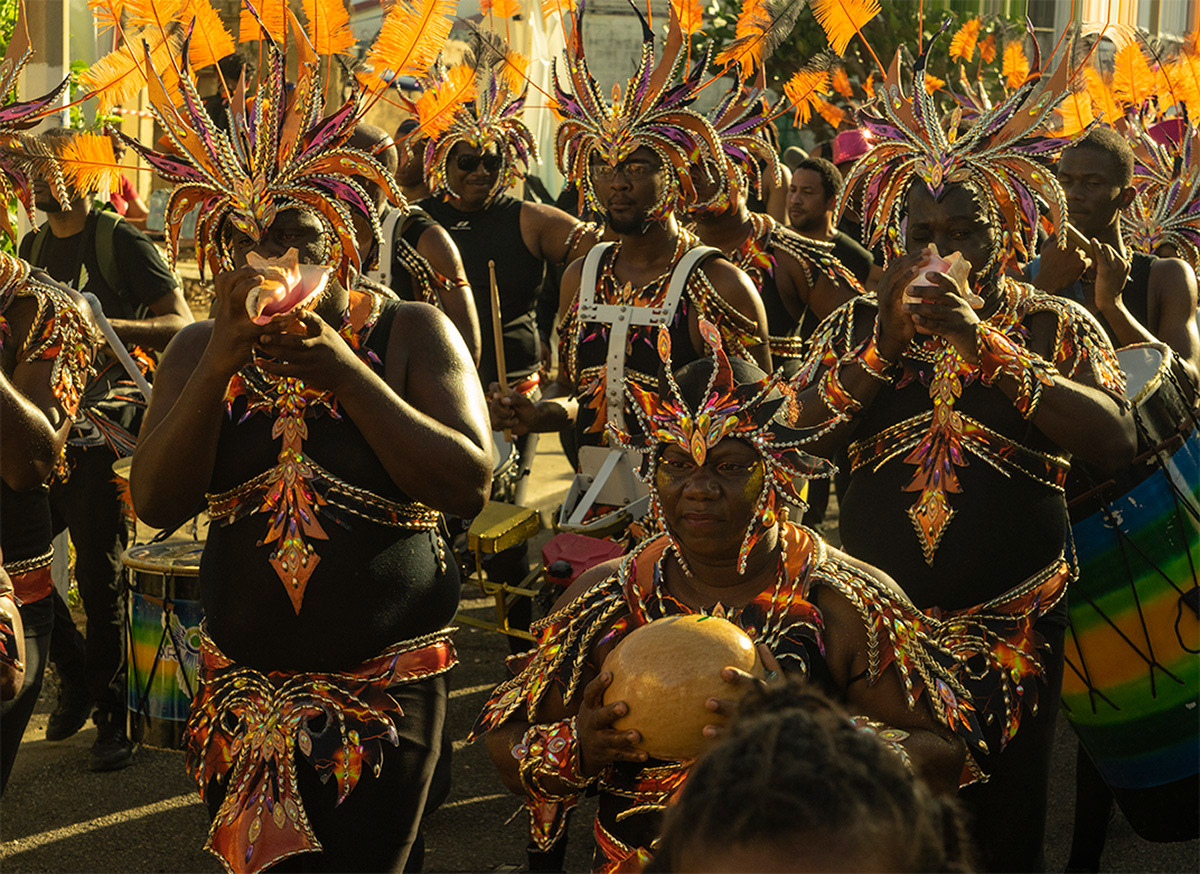
© Don Burmeister. (Click image for larger version)
These rhythms sounded very Congolese, not surprising since the French slave traders brought many Congolese enslaved people (as well as a large number from the Bight of Benin) to Guadeloupe. After slavery ended in 1848, Congolese indentured servants (as well as many from India) came to the islands and had a strong impact on the music. People watching might sway hips or dance with hips and upper body to the rhythms, and five or six times someone came to the center and improvised. As they did, the lead drummer responded to their moves in the Congolese fashion that also marks other Afro-Caribbean dances like Puerto Rican bomba and the bele of Dominica, the island to the south of Guadeloupe.
Men did a lot of kicks and intricate footwork, and might break to the floor or get down low. An older woman did some subtle hip shifts and quite a variety of interesting things, but she was not at all showy. The most spectacular dancer was a tall young woman from Paris who started out with Senegalese high swiveling sabar legs and kicks, before mixing West African moves and circling hips, until she split to the floor. Later, the lead singer, whose name is Franswa La Drez, asked her to dance again. He is, I found out on YouTube, a famous singer and lead guitarist, a founder of the group Akiyo.
GWOKA in Pointe-à-Pitre , Guadeloupe, Feb. 2020 from Don Burmeister on Vimeo.
This Pointe-à-Pitre Gwoka ensemble, perhaps a core from Akiyo itself, was wonderfully intense, but it wasn’t the only Gwoka I heard on Saturday. That night in the center of Le Gosier, at the front of a social service organization, was yet another Gwoka group drumming in the rain. We enjoyed listening to them from the car. They too used a West African djembe as the lead drum – at some point the djembe seems to have replaced the original straight-sided makè. The barrel drum is a bula.
Guadeloupe is an archipelago. The two main islands, Grande-Terre and Basse-Terre form a butterfly, separated by a narrow, river-like channel. The other inhabited islands are Marie-Galante, La Désirade, and two of the islands of Les Saintes. We caught sight of Désirade, a forbidding high chunk, from Pointe des Châteaux, the rugged southeasternmost point on Grande-Terre. Like many tourists we visited Terre de Haut in Les Saintes, south of Basse-Terre. Guadeloupe has splendid scenery and views, but clouds and fog can obscure them. We only caught sight of low-lying Marie-Galante, south of Grande-Terre and known for its slower pace and ox carts, on our last morning, while driving to the airport.
We spent our first five nights in Le Gosier in southern Grande-Terre, a limestone covered island with karst hills in the south and a flat sugar-cane growing north. On Sunday, for our first big Carnaval parade, we planned to go to Baie-Mahault just over the Rivière Salée in Basse-Terre. But Guadeloupe is an overseas department of France. And at breakfast looking out at the pretty garden courtyard of Les Bananiers, a Guadeloupean couple in Le Gosier for a weekend of yoga told us that the parade in Baie-Mahault had been canceled for a very French reason: a strike by municipal workers.
A big parade in the town of Capesterre in a banana growing region on the flat southeast coast of mountainous Basse-Terre was our alternative choice and we headed there early, as directed, to claim an easy exit parking space. We walked into town, passing the fenced area for the judges – and the run up to it, with a string of food stalls on the path we walked on. People were already in the chairs they had brought, here, close to the judging station, and in town, too. We walked all through the town to a river at the edge and back to get a bite to eat at a small simple restaurant with outdoor seating – and a bathroom.
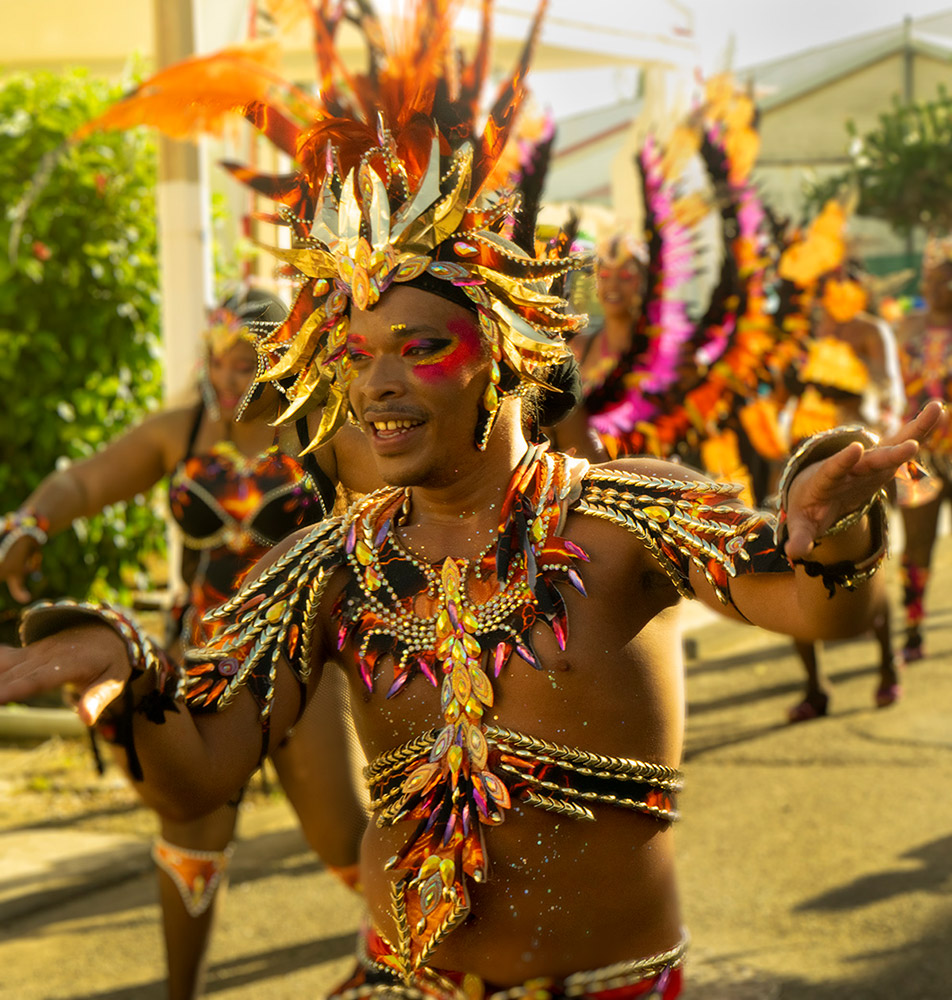
© Don Burmeister. (Click image for larger version)
Right down the road, on the main street, we found a shaded spot on steps to sit on, amid groups of friends and families who had brought their own chairs. Dedicated Carnaval-going entails waiting, which allows you to watch the crowd, the vendors passing through, the little boys (as young as three) snapping whips, the little girls in tutu skirts and bits of costume. A young man did a spectacular set of flips in the street, even flipping over the linked hands of two people. To music in the air, he was also, with a young woman,, a very accomplished hip winer.
Some people passed by repeatedly and some of these turned out, when the parade was on, to parade as independent people or small groups. The Capesterre parade was, at least in its early hours, loose, with gaps between bands and room for independent participants. There was a group of teenage girls in tutu skirts, boys or men in gorilla suits, some skeletons and devils, too, a few elaborately dressed couples, people with costumes they had made themselves, which sometimes included elements that seemed as if they were left over from previous Carnaval masquerading.
Early on there was a small parade of children, followed by costumed dogs and their owners, and then, after a while, a fairly long defile of cars decorated with the symbols of superheros. Drivers and a few others were dressed like Batman, X-men, Spiderman, the Joker. Horns sometimes honked in rhythm.
The actual parade began much after this, with a group of men in plaid kilts, playing bagpipes. Since Guadeloupe is French, perhaps they represented Brittany (Bretons were among the settlers in Les Saintes). They were white men and thus very unusual. Though Carnaval began with the French 17th and 18th century settlers (and excluded enslaved people), today Guadeloupean Carnaval is decidedly Afro-Guadeloupean.

© Don Burmeister. (Click image for larger version)
The African and the European mix in the people of Guadeloupe and so in their way of celebrating Carnaval. In Capesterre I particularly enjoyed a group with a marcher with a tall staff with a lot of spectacular leaf elements, and women with inventive rustic costumes that looked like shingles of brown leaves that rustled with their active hips – and on their heads, cattle horns. I thought this represented an imaginative take on Africanness – and the dancers were very good.
Imagination ruled in the costumes and the wonderfully varying color combinations of each band. A group of women had piles of cookware (not real) on their heads and there were men with logs on theirs. Although midriffs might be bare or there might be cutouts, the women’s costumes usually had skirts and bikinis, as in Trinidadian-influenced carnivals, was not the mode. Feathers, fringes and bustles of all sorts were activated by hips.
Upper bodies were active too and sometimes as we moved along (we kept settling in a spot and then moving to another) we caught routines with pass throughs and changing formations, arm routines, unisons and pairings. Sometimes a band would stay in place for a while. The pacing of this parade was quite uneven, though it picked up as it – and we – proceeded. A flag bearer usually started off a band, followed by people bearing banners with the names of sponsors and the group and the town they were from. Children were sometimes part of the beginning of a group. And a cart with bottles of water, pulled by the support team, might bring up the rear.
There was always live music. Groups had their drummers (ensembles varied, with snares and bass drums predominating, except for the few groups with small, skin-topped drums under their arms), their chacha shakers, their conch players, or their trumpets and trombones, and occasionally other brass players. Sometimes people chanted or sang, but always there were strong rhythms. Even the few sound trucks had live keyboard and/or guitar players and singers, followed by drummers.
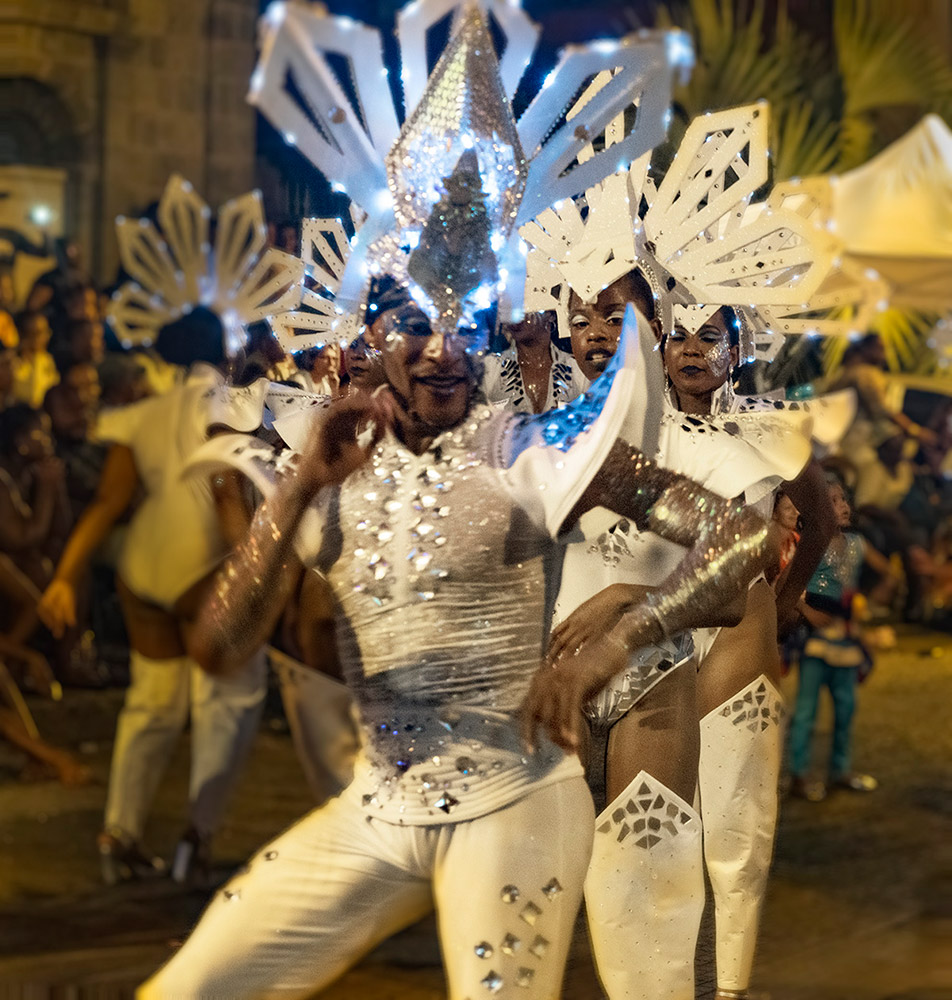
© Don Burmeister. (Click image for larger version)
Most women wore sensible sandals or sneakers, but some wore heels. A band with white costumes and high, wide-spread crystal headpieces wore stilettos. One band, predominantly in green, with a complicated dance routine, was led by four tall men leading the vigorous dancing with very strong contractions. Though gorillas were generally men and independent and might include whip-snapping, there was also at least one organized group of them. And there was a band of woman gorillas in green with padded bottoms.
We kept moving up toward the enclosed, fenced area that led to the judges. Now we were fenced off from the action (and there were people seated in front of us), but we could still see the bands and there were still alluring surprises of costumes, colors, and movements. As the bands got to the judging they did their routines, pumping up hips and sharpening moves and formations, even though this was at the very end of the parade.
We had been in Capesterre for many hours, it was dark now, and we made our way back to the car. We never saw the end of this parade nor of the two others we eventually caught in Guadeloupe’s capitol, Basse-Terre, the parade by night on Lundi Gras and the climactic finale, the parade from afternoon deep into the night on Mardi Gras.
This was more than a week away. We shifted to Basse-Terre and the multiple pleasures of this very beautiful volcanic island, moving the next day to the southern town of Trois-Rivières to stay at Diva Chez Dora, a small b&b, presided over by ebullient hostess and wonderful cook Dora, originally from the island of Dominica, and her husband Bruno from France.
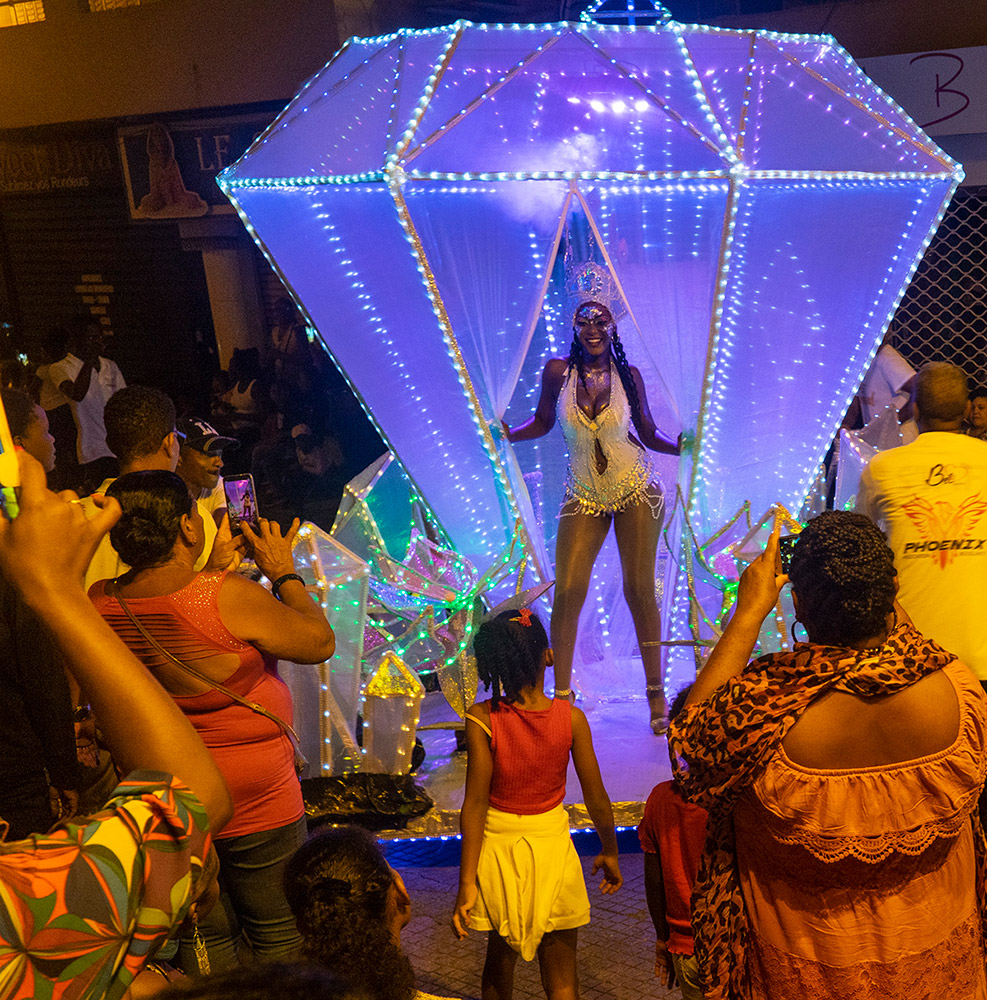
© Don Burmeister. (Click image for larger version)
From Trois-Rivières we took the ferry to Les Saintes, whose sharp peaks give it an unusually beautiful harbor. The next morning we went to the archeological park with pre-Columbian petroglyphs and then headed all the way up the east coast, pausing in the northern town of Sainte Rose, and then around to the wonderfully scenic mountainous west coast of Basse-Terre. In Sainte Rose a few boys in painted faces and bits of costume asked drivers for money, a remnant of Carnaval’s social reversals and attempts to scare, part of the idea of misrule also represented by skeletons, devils, and now, in the 21st century in Guadeloupe, gorillas. The boys were not scary, however, nor were a few other similar groups of boys we encountered on the west coast.
This minor reminder of Carnaval was just that as we shifted to the touristic pleasures of the west coast, including, our first day, the lush and beautifully designed botanical garden in Deshaies. A very large part of the interior is a mountainous rain-forested national park and from the transverse road across it we found muddy, rooty trails to hike in and a zoo in the rain forest, enhanced with vivid tropical flowers and a long series of elevated walkways to view the forest from above.
Friday night there was a Carnaval night parade in Deshaies, but although we were staying at Bikamado, an apartment cabin in the southernmost part of the commune of Deshaies, we were oriented to the town to the south, Pointe Noire, and places south of that like the transverse road and the tourist center, Malendure. There on Friday we took a boat trip to snorkel at the coral reefs of Ilets de Pigeon, in Guadeloupe’s Réserve Cousteau. Returning to Bikamado we thought only of making dinner, not the night parade, knowing we would see one on Monday in the capitol, Basse-Terre.
Nor were we tempted by Carnaval activities that weekend in Pointe-à-Pitre, like the Mas Maten (morning masquerade) on Saturday of marchers in costumes full of natural materials like fiber skirts or colorful prints, nor that city’s big Sunday parade. We relocated on Saturday to Basse-Terre’s suburb Saint Claude, which climbs the foothills of the still live volcano La Soufrière and provides access to hiking trails on it. We were fortunate to stay at Habitation La Reine de Camp Chambres d’Hôtes, a 19th century great house with a big veranda, comfortably furnished with antique accents and old pictures and books of Guadeloupe.
Starting up the trail to the volcano on Monday, we planned only to go up the easy stone path and steps to Pas de Roy, through the plush rain forest into the still lush but dwarfed rain forest, and were almost there, when it started to rain – and did not stop. Drenched, we retreated, washed our clothes, dried out, and were ready that evening for the Lundi Gras night parade.
Dancers at Lundi Gras parade, Basse-Terre, 2020 from Don Burmeister on Vimeo.
The night parade was full of lights, lots of little lights, white and many colors, that framed floats, costumes, and sailed high on headdresses. This was extremely festive. The lights were inventively used, accenting the bands and even the independent masqueraders who marched between the groups – skeletons, nuns, just a few gorillas, and others outfitted with glitter and lights.
We parked on the road to Saint Claude and walked past the carpeted judging area, which was empty at that early time, then walked past a plaza filled with chairs (and early arrivers), and down the hill lined with chairs to downtown’s commercial center. Lacking our own chairs, we decided to sit on the steps of the cathedral, in front of which we were sure that bands would stop and dance their routines.
Our location even provided a popular food truck and, best, a municipal twenty cent toilet station – we were set for the evening. An uninspired parade of cars led off, but soon Carnaval bands followed. The first were groups with skin-topped small drums under their arms, community groups with a politically aware slant, and less lavish, more home-made costumes that still included imaginative displays of lights. Such groups apparently began in the late 20th century as a way to include all kinds of people who might not be able to afford to buy an elaborate costume and who wanted to assert their Afro-Guadeloupean identity and concerns about problems with French rule and ruling class.
One group, Orange is the New Green (in English), had a decidedly ecologically aware message. They collected garbage from spectators, a wonderfully useful service, and gave out orange cups inscribed with “Orange is the New Green.” Then began the many bands with the elaborate displays of colorful costumes, decorated not just with sparkle and glitter and fringe and feathers, capes and bustles, cardboard cutouts, and all kinds of complicated constructions, but for this parade included those enticing arrays of little lights.
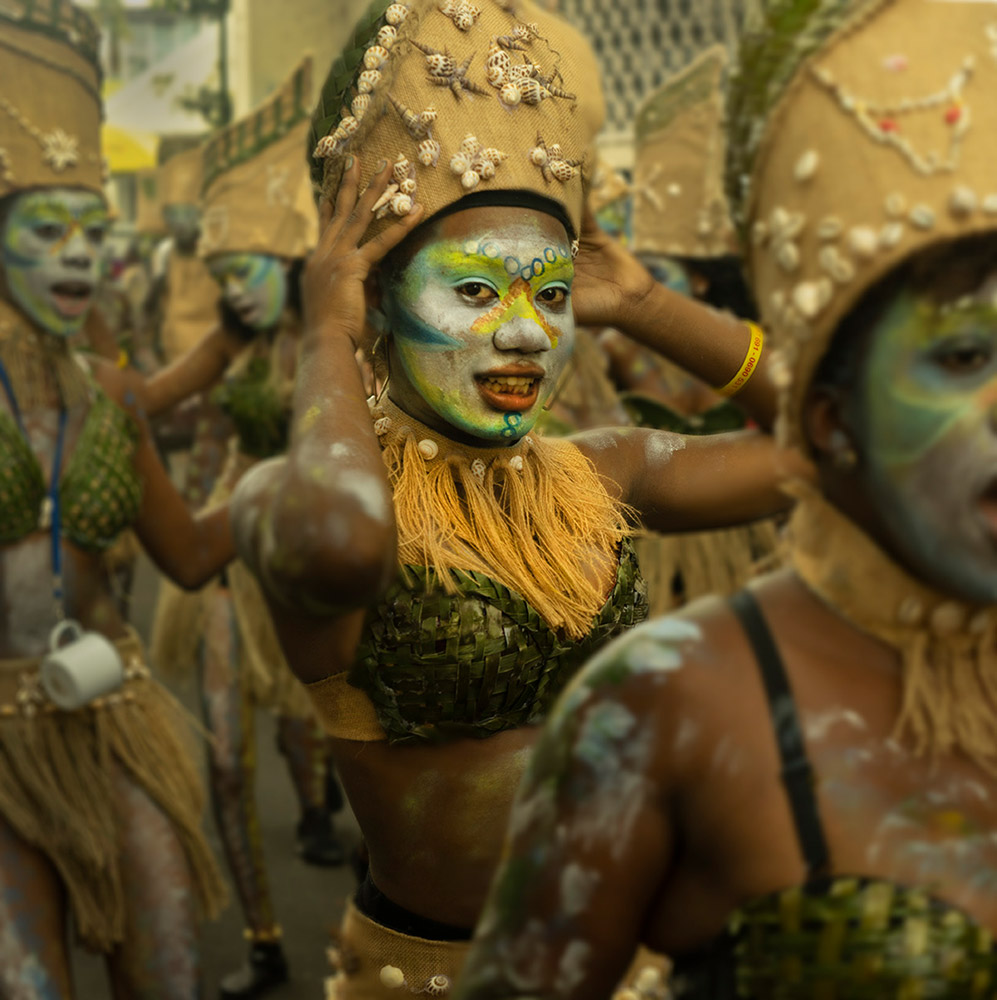
© Don Burmeister. (Click image for larger version)
Many bands had flag wavers, often multiple, and banner holders to lead, but some led with floats, or expert dancers, male or female, in front of a float. On the float there was usually a woman, or occasionally a man, who smiled and danced, shifting and rotating and thrusting hips, even if she was the one who had to pull the float. Bigger floats were pulled by men who turned the float around so that we could see all sides of it.
The floats were festive, but the hip-swaying marchers and dancers in the lit up and many-colored constructed costumes were more so. They did stop and dance routines in front of the cathedral. Not everyone was equally good; these were amateurs, but the best were terrific. Footwork was usually simple, but formations were varied, side to side, passing through, waving arms, all the while keeping hips going. Hips churned, revolved, made subtle or vigorous accents.
Backing the dancers were the musicians, usually rows and rows of drummers – with drum heads, snare heads, not too many pan-top drums, and lots of big bass drums, generally not of the big blue plastic type. A couple of groups had drummers with multiple small drums strung together. Chacha players shook it up. Sometimes conch players hooted, but there were many trumpets and trombones and a few larger ensembles that included more brass, like saxophones. There were also a few of the soundtrucks with keyboards and guitars and amplified singers. For one, a man danced and emceed, initiating a call and response chant. Songs and rhythms varied, but bands kept returning to the insistent rhythm of Carnaval.
After the musicians, also colorfully clad, and lit up, but in costumes that were different, covered up and usually less flamboyant than the dancers, there was often a final group of dancers to enliven the band. And sometimes after them, came groups of followers, marching or dancing along.
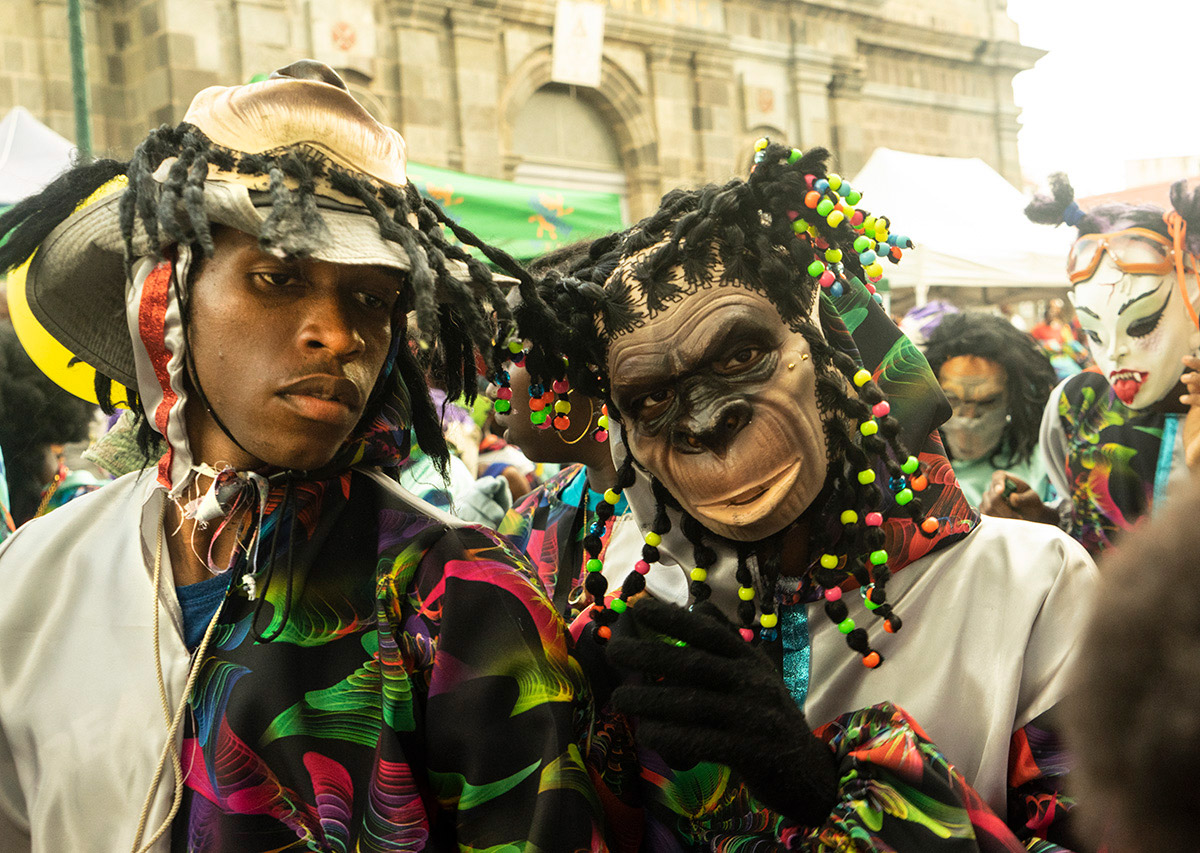
© Don Burmeister. (Click image for larger version)
The next day was not the final parade of Guadeloupean Carnaval, though it was the climactic, Mardi Gras celebration. On Ash Wednesday, in various places on the islands, there is a parade of people in black and white who march to burn and bury Vaval, the King of Carnaval. And there is an unusual mid-Lenten parade, too, cancelled this year because of Covid-19.
For us, on Tuesday, February 25 in Basse-Terre, the long, wonderful, grand parade was a sumptuous conclusion to Carnaval, taking up most of the day and night. Waiting and relaxing, again on the cathedral steps, in the back of a tent where those who did not know the people in front were allowed to perch, was part of the pleasure of the day.
We watched groups of people assemble in front of us, greeting each other with a kiss on each cheek. They brought coolers full of water, juice, and rum. Little girls danced and ate puffs of cotton candy. A dj continually played inviting music – zouk, compas, and other Guadeloupean and Caribbean rhythms and songs.
Across the road was a judging station, for music. The judging area for dance was up the hill, at the beginning of the parade, so that in Basse-Terre masqueraders danced for judges with fresh energy. The early paraders were again those from community groups, less elaborately clad and with socio-political aims, with drums slung under their arms, chachas, conches, and occasionally cowbells or iron to strike. One such group had clever costumes with fringes cut from magazines.

© Don Burmeister. (Click image for larger version)
As before, most bands had very colorful, complicated costumes, designed for display and showing off their moves and flair. The variety, the color combinations, the changes from group to group, added to the pleasure. Headdresses were complex and high for extra visibility. Back pieces on the hips, emphasizing them, or higher on the torso might splay out with intricate flares. I particularly enjoyed a group in which all the women looked like flowers, with big cloth petals on their costumes and headdresses. Some groups had floats, some didn’t, though the number of bands with floats seemed to increase during the day and some even had two.
Though the great majority of dancing mas players were women, rotating, swinging, contracting pelvises, the fewer men were often more athletic. They wined their hips, too, but also kicked high, and moved with strong in and out knees. Dancing roles in Carnaval seemed to attract men who were particularly good at dancing, whereas the many women could be expert or not. The best were dynamic, strong, and emphatic, and some showed wonderful subtleties in their moves.
This long parade with over 50 bands was generally more compactly timed, so that there was often a group waiting behind the ones performing in front of us and the judges. Again, there were some bands behind soundtrucks with live musicians, and some with call and response from singers in the band, and a few that led call and response with those watching. One dancing lead singer was particularly good at getting the audience to sing what seemed to be a Guadeloupean folksong that everyone knew.
The emcee directing the mas players in front of the judges was warm, expert, and generous. The band would stop and he would give them 2, 2½, or 3 minutes (obviously a special “maximum” privilege) to perform their musical arrangement after his countdown. After featuring their music for the judges, they would play for the dancers in front to dance their routines. The gracious emcee would always send them off, “5, 4, 3, 2, 1, partir,” with some words of encouraging praise. Many of the bands were deemed “extraordinaire.”
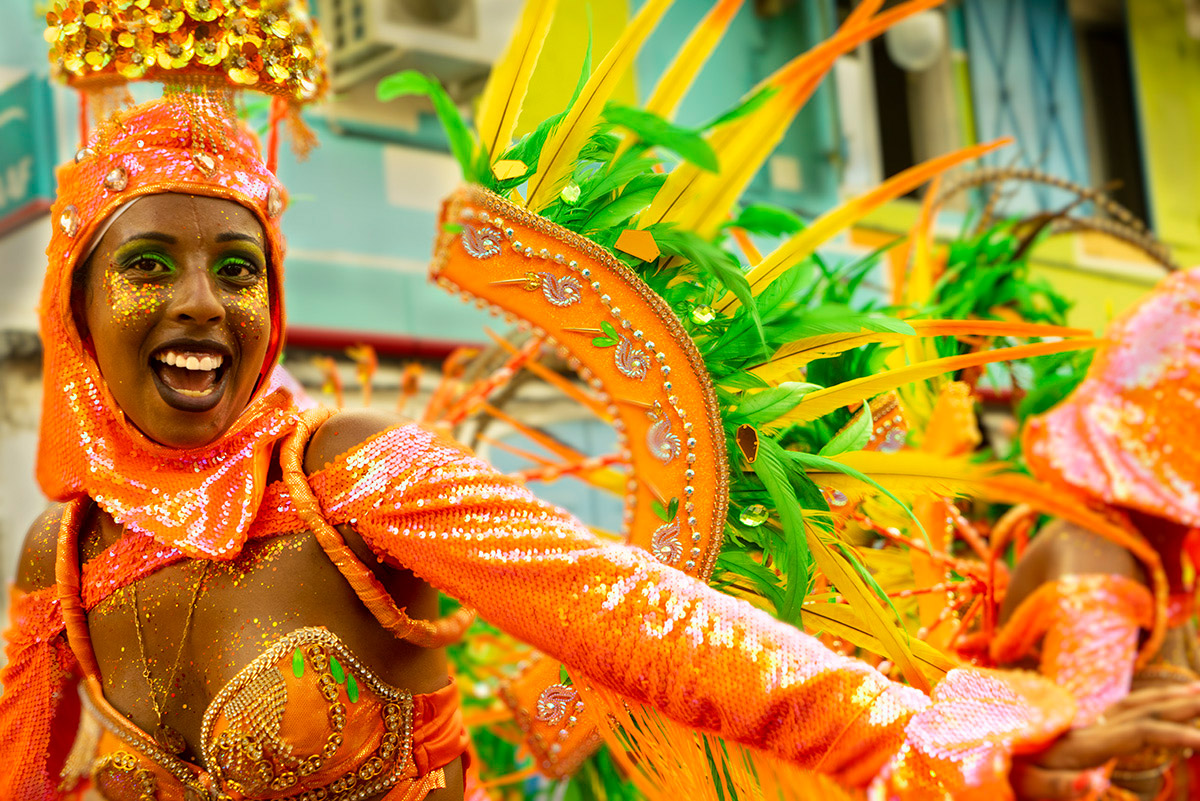
© Don Burmeister. (Click image for larger version)
Watchers are also participants, and some danced as the parade went on. One pregnant woman, a friend of the people in front of me, seemed possessed, rolling her hips, dancing and dancing, within the group or on the road beside the masqueraders and sometimes with some of them. Others, too, went up to people playing mas and danced with them.
At one point there was a designated pause of perhaps half an hour. The dj played contagious dance music, and much dancing erupted before me. Some danced passionately, much fun to watch. People danced alone, women danced with women, and women danced with men. A group of about five women and men began wining together. When the dj played an inveigling slow song, couples embraced and danced sensuously together with rich, slow, full body curves.
I spent most of the parade in the back of the tent, but after quite a while, moved to the edge of the road where I was right next to the masqueraders. And eventually from there we began to move along the street and up the hill, encountering band after band, color schemes and costume schemes in great variety. Big groups of gorilla fronted bands (some with whips) had a satiric, clowning edge despite their scary masks. It was late into the night and the Carnaval was still going strong. We reached the edge of the judging area and watched group after group emerge to get their countdown and dance. It was almost midnight when we left, with more inviting groups to go.
Currently none of us go to carnivals. We see no processions. We shelter in place. We stay at home, avoiding infection. But the internet invites the world in. And if you want to see the Basse-Terre Mardi Gras masqueraders in front of the initial judges, you can see (or skip around) more than ten hours of this on YouTube. Here’s a link to part one, the first eight hours (starting with a group dancing to gwoka musicians – who don’t march – that I didn’t see) (I embed the video earlier in this feature. Ed)
You can also see a couple of hours of the night parade of Lundi Gras. And for something shorter and up close, here’s seventeen minutes of a band, Le Guimbo, with excellent dancers in the streets of Basse-Terre…








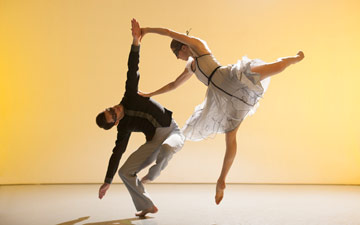
You must be logged in to post a comment.